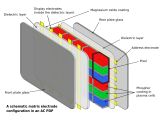Televisions have been in our lives for almost eight decades. Technology has evolved a great deal during this time, however most of the televisions still benefit from the services of the old faithful cathode ray tube to display images. Cathode ray tubes basically work by firing electrons at a glass target coated with a substance that gives off light, such as phosphorus. By controlling the intensity of the electrons and the direction of the electron beam, images are being produced.
But cathode ray tubes have a great disadvantage. In fact, there are two, to be more precise: one would be that they are rather bulky, which ultimately makes them heavy as well. Imagine having a big screen TV, equipped with a cathode ray tube weighing several tens of kilograms. Now, imagine moving it on your own.
In the last few years, a new technology has appeared that promises to help us get rid of the big heavy CRT without losing an inch of screen width: the plasma flat panel display. Unlike CRTs, plasma flat panel displays do not require increased lengths in which the electron beam must be directed. Instead, the phosphorus coated glass target and electron beam system is replaced by so-called pixels, small dots distributed along the whole surface of the screen.
CRT displays may also rely on pixels to produce images, but in plasma flat panel displays the ionization of the fluorescent coating is realized through a technique that doesn't require long electron beams.
Plasma
We generally call plasma a volume of gas containing free flowing ions inside it, or electrically charged particles. Usually, gases experience zero electrical charge in normal atmospheric conditions of temperature and pressure. But, gases may be electrically charged, whether by losing or gaining an electron. The presence of free-flowing electrically charged particles inside a gas will eventually determine a flow of electric current, in order to establish a balance inside the gas mix.
Excited particles collide with each other, which excites even more particles. Ultimately, the gas atoms in the plasma will experience an energetic unbalance and will need to release some energy, usually by emitting electromagnetic radiation, or photons of light. The gases usually used in plasma flat panel displays are xenon and neon, which emit light in the ultraviolet wavelengths that is then converted into visible light.
How it works
Each pixel in modern television screens, and in plasma television in special, is made out of three sub-pixels, each representing the color red, green and blue. These sub-pixels, or cells, contain xenon and neon gas and are placed between two glass plates. So-called address electrodes and display electrodes are placed behind the cells, respectively in front, after which they are insulated with a dielectric material and protective layer.
The display electrodes are arranged horizontally while the address electrodes are arranged vertically, thus creating a grid that can light up any of the pixels of the screen at a given time. As the plasma TV receives the command to light a particular pixel on the screen, electrical signals are sent through the two sets of electrodes to the cells of the respective pixel.
The electric current transmitted through the electrodes flows into the gas of the cell, determining the ionization of the gas which starts to release ultraviolet radiation. Because each cell is coated with phosphorus, the ultraviolet radiation is being absorbed immediately and re-emitted in the form of visible light. The combination of all the pixels on the screen lighting up in different ways produces an image.

 14 DAY TRIAL //
14 DAY TRIAL // 
